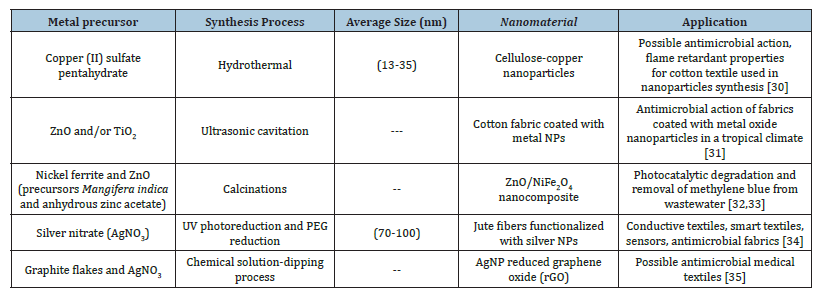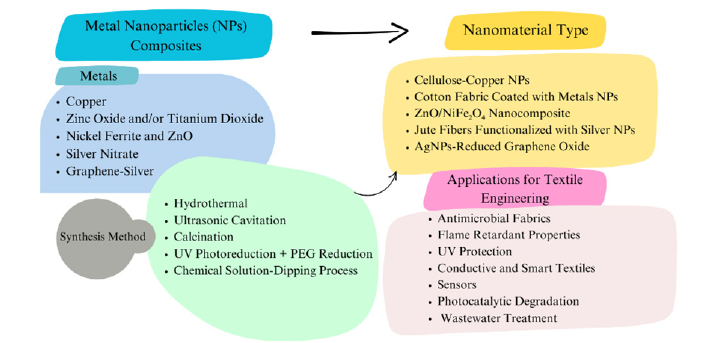- Submissions

Full Text
Trends in Textile Engineering & Fashion Technology
Nanomaterial Based on Metal-Doped Carbon Dots for Textile Applications
Luma C Belluzzo1, Teófanes B Serna1, Egberto Munin2,3 and Viviane Pilla1*
1Grupo de Propriedades Ópticas e Térmicas de Materiais (GPOTM), Instituto de Física, Universidade Federal de Uberlândia (UFU), Uberlândia, Brazil
1Anhembi Morumbi University (UAM), São José dos Campos, SP, Brazil
1Center of Innovation, Technology and Education (CITE), São José dos Campos, SP, Brazil
*Corresponding author:Viviane Pilla, Universidade Federal de Uberlândia-UFU, Av. João Naves de Ávila 2121, CEP 38.400- 902, Uberlândia, MG, Brazil
Submission: March 17, 2025;Published: March 21, 2025

ISSN 2578-0271 Volume10 Issue4
Abstract
Fluorescent nanomaterials based on carbon dots (Cdots) doped with several metals have been in increasing development for bioapplications. Green synthesis of fluorescent carbon dots has increased using different carbon sources, such as seeds, flowers, and roots, due to their possible environmental friendliness and relatively low cost. These Cdots have been doped, functionalized or encapsulated with different groups for specific applications. This work reports advanced nanomaterials based on Cdots synthesized using several carbon sources in the presence of the metals for textile applications. The fluorescence quantum yield () photophysical parameters are presented for some metal-doped Cdots as an important nanomaterial for several technological applications. These metal-based carbon dots materials can be used for photocatalytic degradation of textile dyes, minimizing waste in the textile industry, self-cleaning and antibacterial cotton fiber, and improving the properties of fabrics as potential antifungal and bactericidal agents for several bioapplications. An overview of different Cdots is presented in the presence of metals and other metallic nanoparticle composites developed to degrade dyes of interest in textile fabric production and textile engineering.
Keywords:Carbon Dots; Metal; Fluorescence quantum efficiency; Textile application
Introduction
Different green syntheses of fluorescent carbon dots (Cdots) are being developed using several raw materials such as food, fruits, roots, seeds, leaves, oils and animal wastes [1- 6]. Cdots are reported to be spherical or semi-spherical, with average sizes typically below 10nm. They exhibit fluorescent properties, enabling various applications across different fields, including textiles [7,8]. The sustainable synthesis of carbon dots continues to attract considerable attention and interest due to their relatively simple production and low toxicity [9,10]. Thus, considering environmental sustainability and availability of natural resources, carbon-based nanomaterials stand out as alternatives to metals, metal oxide materials, and inorganic quantum dots for various applications such as catalysts, sensors, lighting sources, and biomedical purposes [11-21]. Several studies have used green carbon dots as metal ion sensors such as Fe3+, Fe2+, Hg2+, Cu2+, Cd2+, Cr6+, Co2+, Al3+, Au3+ and Ag+ [15,16,18,20,21]. However, functional (nano)materials such as metal nanoparticles, and metal oxides, have been inserted or linked in carbon dots to develop the composite probes [21]. Metal-based carbon dots composites have been developed for several technological applications, such as optoelectronics, sensors, fuel cells, photocatalysts, light-emitting diodes [21-23]. The Agdoped C-dots and Au-doped Cdots synthesized using the low melting point metals route, were reported for the first time in 2019 for possible neural tissue engineering applications [24]. The iron-doped Cdots were synthesized for the first time using ultrasound-assisted methodology, for possible bioimaging and diagnostic devices applications [25]. However, nanomaterials based on copper, silver or iron metal-doped Cdots have been proposed using different carbon sources such as Iles paraguariensis, L-cysteine, sodium alginate, and citric acid [26-29]. This work presents an overview of metal-doped carbon dots and their applications in the textile industry, including effective industrialization of textiles, degradation of textile wastewater, applications of self-cleaning and antibacterial cotton fibers [26-29]. The synthesis method used, the average sizes of Cdots, and relevant information about fluorescence of the metal-doped Cdots, such as the fluorescence quantum yield (η) parameter, along with the emphasis on their applications in textiles, are presented. In addition, studies developed are reported using other synthesis of metal-doped nanoparticles (NPs) such as cellulose-copper nanoparticles by using green synthesis [30], composite materials of cotton fabric coated with metal oxide NPs for antibacterial properties [31], oxide NPs for degradation of dye from wastewater [32,33], fibers functionalized with silver NPs [34], silver-graphene coated textile composites [35], aiming applications in textile development and smart textiles [30-35].
Discussion
Table 1 presents several nanomaterials based on metal-doped Cdots or metal-based carbon dots composites, synthesized by the hydrothermal method, and developed for textile engineering applications [26-29]. Nanosilver doped-Cdots (AgNPs-Cdots) have been investigated for textile applications, in production of antimicrobial and UV-resistant cotton fabrics [26]. Several carbon antioxidant precursors such as (L-cysteine, citrate, and ascorbic acid) and transition metal ions (copper (II), zinc (II) and titanium (IV)) have been reported for optimization of the best performance of copper (II)-doped carbon-based nanomaterials (Cu- doped Cdots) [27]. The Cu-doped Cdots have been developed for a catalytic ozonation oxidation process for textile wastewater treatment [27]. On the other hand, silver nanoparticles (AgNPs) synthesis was carried out on Cdots-coated onto the activated cotton fibers for self-cleaning and antibacterial textiles [28]. In addition, hydrothermal synthesis process was used for the surface functionalization of magnetite (Fe3O4) with the Cdots (HT-Cdots), using Ilex paraguariensis (yerba mate YM) as carbon source, for possible photocatalytic degradation of textile wastewater through the photo-Fenton reaction [29]. Figure 1 presents an overview of the metal-doped Cdots and metal-carbon dots nanocomposites synthetized for textile applications [26-29].
Table 1:Several carbon sources have been presented for metal-doped Cdots or metal-carbon dots nanocomposites, by hydrothermal synthesis and textile applications. The average sizes of the Cdots, doping material, and the parameter are presented.

aSilver nanoparticle was synthesized on the surface of the Cdots coated cotton fabric [28]
bHydrothermal routes for CdotsN synthesis using HNO3 [29]
cHydrothermal routes for CdotsS synthesis using H2SO4 [29]
dCdots coated magnetic nanoparticles (HT-Cdots) using hydrothermal synthesis [29]
Figure 1:Overview of metal-doped Cdots and metal-carbon dots nanocomposites synthetized for textile applications [26-29].

Table 2 presents metal-doped nanoparticles [30-35] synthesized for textile interest. The green synthesis using cotton textile fibers (commercial cellulose) for metallic copper nanoparticles development is present as reducing agent and stabilizer [30]. Antimicrobial action of fabrics coated with metal oxide ZnO and/ or TiO2 nanoparticles in a tropical climate was reported [31]. Zinc oxide nanoparticles and ZnO/NiFe2O4 nanocomposite have been proposed for methylene blue dye degradation from textile wastewater [32,33]. On the other side, jute fibers functionalized with silver NPs have been proposed for improved conductivity values and potential for application in smart textile composites [34], and silver-graphene nanocomposites have been synthesized for possible antimicrobial medical textile [35]. Figure 2 presents the overview of several metal NPs composites developed for textile improvement [30-35].
Table 2:The different metal nanoparticles (NPs) composites, NPs size average, and the applications in the textile area.

Figure 2:Overview of several metal nanoparticles (NPs) composites synthetized for textile applications [30-35].

Several metal-doped nanocomposites are being developed for applications of interest in textile engineering, however, the fluorescence characterizations of these nanomaterials are still strictly investigated for possible photoelectronic devices, as well as the possibility of developing novel metal-doped carbon dots using green synthesis for environmentally friendly applications. Finally, other chemical elements, such as boron and nitrogen, have been used to dope or co-dope carbon dots through hydrothermal green synthesis for the multifunctional cotton fabrics [36-38]. This highlights nanomaterials-based carbon dots as valuable tools for various textile applications.
Conclusion
Novel nanomaterials based on copper, silver or iron metaldoped Cdots have been proposed using different carbon sources such as sodium alginate, L-cysteine, Iles paraguariensis, and other chemical sources. This work presented an overview of metal-doped Cdots using green synthesis for environmentally friendly applications, as tools for several textile applications such as effective industrialization of textiles, degradation of textile wastewater, applications of self-cleaning and antibacterial cotton fibers. In addition, studies developed are presented using other synthesis of metal-doped nanoparticles, such as cellulose-copper nanoparticle by using green synthesis, silver-graphene coated textile composites, aiming applications in textile development. Over the years, new synthesis of metal and carbon dot composites have been proposed targeting different research areas, enabling the development of relevant applications in textile engineering.
Acknowledgment
The authors would like to thank the Brazilian funding agencies Conselho Nacional de Desenvolvimento Científico e Tecnológico (CNPq), Fundação de Amparo à Pesquisa do Estado de Minas Gerais (FAPEMIG), CAPES, and Instituto Nacional de Ciência e Tecnologia de Fotônica INCT/CNPq for their financial support.
Conflicts of Interest
The authors declare that there are no conflicts of interest.
References
- Wang H, Su W, Tan M (2020) Endogenous fluorescence carbon dots derived from food items. Innovation 1(1): 100009.
- De B, Karak N (2013) A green and facile approach for the synthesis of water soluble fluorescent carbon dots from banana juice. RSC Adv 3: 8286-8290.
- Hsu PC, Shih ZY, Lee CH, Chang HT (2012) Synthesis and analytical applications of photoluminescent carbon nanodots. Green Chem 14: 917-920.
- Suvarnaphaet P, Tiwary CS, Wetcharungsri J, Porntheeraphat S, Hoonsawat R, et al. (2016) Blue photoluminescent carbon nanodots from limeade. Mater Sci Eng C 69: 914-921.
- Lima SR De, Costa TV, Santos TTS, Felipe DG, Serna TB, et al. (2024) Optical characterization of fluorescent chitosan-based carbon dots embedded in aqueous natural dye. Colorants 3(4): 269-281.
- Salman BI, Hassan AI, Hassan YF, Saraya RE, Batakoushy HA (2023) Rapid one-pot microwave assisted green synthesis nitrogen doped carbon quantum dots as fluorescent precursor for estimation of modafinil as post-covid neurological drug in human plasma with greenness assessments. J Fluoresc 33(3): 1101-1110.
- Felipe DG, Serna TB, Andrade AA, Pilla V (2024) Synthesis of fluorescent carbon dots from raw materials: An overview of textile applications. Trends Textile Eng Fashion Technol 10(1): 1155-1159.
- Ghazal H, Shaker S, Abdelaziz E (2023) Synthesis of carbon dots and its applications in textiles. Egypt J Chem 66(12): 71-86.
- Himaja AL, Karthik PS, Singh SP (2015) Carbon dots: The newest member of the carbon nanomaterials family. Chem Rec 15(3): 595-615.
- Zhao S, Lan M, Zhu X, Xue H, Ng TW, et al. (2015) Green synthesis of bifunctional fluorescent carbon dots from garlic for cellular imaging and free radical scavenging. ACS Appl Mater Interfaces 7(31): 17054 -17060.
- Liu X, Dai L (2016) Carbon-based metal-free catalysts. Nat Rev Mater 1: 16064.
- Song Y, Zhu S, Xiang S, Zhao X, Zhang J, et al. (2014) Investigation into the fluorescence quenching behaviors and applications of carbon dots. Nanoscale 6: 4676-4682.
- Vandarkuzhali SAA, Jeyalakshmi V, Sivaraman G, Singaravadivel S, Krishnamurthy KR, et al. (2017) Highly fluorescent carbon dots from pseudo-stem of banana plant: applications as nanosensor and bio-imaging agents. Sens Actuators B Chem 252: 894-900.
- Qurtulen, Ahmad A, Shahraki HS, Khan N, Ahmad M, et al. (2024) One-pot synthesized fluorescent CDs from Syzygium Cumini for metal ion sensing and cell imaging. Inorg Chem Commun 160: 111883.
- Yu J, Song N, Zhang YK, Zhong SX, Wang AJ, et al. (2015) Green preparation of carbon dots by Jinhua bergamot for sensitive and selective fluorescent detection of Hg2+ and Fe3+. Sens Actuators B Chem 214: 29-35.
- Jeeva D, Velu KS, Mohandoss S, Ahmad N, Padmini S, et al. (2024) A facile green synthesis of photoluminescent carbon dots using pumpkin seeds for ultra-sensitive Cu2+ and Fe3+ ions detection in living cells. J Mol Struct 1312: 138543.
- Da X, Han Z, Yang Z, Zhang D, Hong R, et al. (2022) Preparation of multicolor carbon dots with high fluorescence quantum yield and application in white LED. Chem Phys Lett 794: 139497.
- Tripathi KM, Tran TS, Kim YJ, Kim TY (2017) Green fluorescent onion-like carbon nanoparticles from flaxseed oil for visible light induced photocatalytic applications and label-free detection of Al(III) ions. ACS Sustainable Chem Eng 5(5): 3982-3992.
- Jing HH, Bardakci F, Akgöl S, Kusat K, Adnan M, et al. (2023) Green carbon dots: Synthesis, characterization, properties and biomedical applications. J Funct Biomater 14(1): 27.
- Kanwal A, Bibi N, Hyder S, Muhammad A, Ren H, et al. (2022) Recent advances in green carbon dots (2015-2022): Synthesis, metal ion sensing and biological applications. Beilstein J Nanotechnol 13: 1068-1107.
- Sahu Y, Hashmi A, Patel R, Singh AK, Susan MABH, et al. (2022) Potential development of N-doped carbon dots and metal-oxide carbon dot composites for chemical and biosensing. Nanomaterials 12(19): 3434.
- Mandani S, Sharma B, Dey D, Sarma TK (2015) Carbon nanodots as ligand exchange probes in Au@C-dot Nanobeacons for fluorescent turn-on detection of biothiols. Nanoscale 7: 1802-1808.
- Xu H, Xu L, Ahmed A (2023) Carbon quantum dots-decorated ZnO heterostructure nanoflowers grown on nanofiber membranes as high-efficiency photocatalysts. Diam Relat Mater 136: 109972.
- Kumar VB, Kumar R, Gedanken A, Shefi O (2019) Fluorescent metal-doped carbon dots for neuronal manipulations. Ultrason Sonochemistry 52: 205-213.
- Perelshtein I, Perkas N, Rahimipour S, Gedanken A (2020) Bifunctional carbon dots-magnetic and fluorescent hybrid nanoparticles for diagnostic applications. Nanomaterials 10(7):1384.
- Alzahrani SO, Al-Ghamdi SA, Alsahag M, Alatawi K, Alaysuy O, et al. (2023) Nanosilver-doped carbon quantum dots for industrialization of efficacious textiles with superior UV-resistance and antimicrobial performance. Diam Relat Mater 138: 110249.
- Cardoso RMF, Cardoso IMF, Silva LP da, Silva JCGE da (2022) Copper (II)-doped carbon dots as catalyst for ozone degradation of textile dyes. Nanomaterials 12(7): 1211.
- Barani H, Nejad MS, Esmailzadeh M, Sheibani G, Sheibani H (2024) Synergistic carbon quantum dots and silver nanoparticles for self-cleaning and antibacterial cotton fibers. Cellulose 31: 6565-6577.
- Monje DS, Mercado DF, Mesa GAP, Valencia GC (2023) Carbon dots decorated magnetite nanocomposite obtained using yerba mate useful for remediation of textile wastewater through a photo-fenton treatment: Ilex Paraguariensis as a platform of environmental interest-part 2. Environ Sci Pollut Res 30(2): 3070-3087.
- Pérez-Álvarez M, Cadenas-Pliego G, Pérez-Camacho O, Comparán-Padilla VE, Cabello-Alvarado CJ, et al. (2021) Green synthesis of copper nanoparticles using cotton. Polymers 13(12): 1906.
- Veselova VO, Plyuta VA, Kostrov AN, Vtyurina DN, Abramov VO, et al. (2022) Long-term antimicrobial performance of textiles coated with ZnO and TiO₂ nanoparticles in a tropical climate. J Funct Biomater 13(4): 233.
- Modi S, Yadav VK, Gacem A, Ali IH, Dave D, et al. (2022) Recent and emerging trends in the remediation of methylene blue dye from wastewater by using zinc oxide nanoparticles. Water 14(11): 1749.
- Adeleke JT, Theivasanthi T, Thiruppathi M, Swaminathan M, Akomolafe T, et al. (2018) Photocatalytic degradation of methylene blue by ZnO/NiFe2O4 Appl Surf Sci 455: 195-200.
- Ferreira DP, Ferreira A, Fangueiro R (2018) Searching for natural conductive fibrous structures via a green sustainable approach based on jute fibers and silver nanoparticles. Polymers 10(1): 63.
- Noor N, Mutalik S, Younas MW, Chan CY, Thakur S, et al. (2019) Durable antimicrobial behaviour from silver-graphene coated medical textile composites. Polymers 11(12): 2000.
- Cheng S, Wang C, Zhang H, Zou H, Zuo D (2022) Study on the ultraviolet absorbing properties of cotton fabric finished with boron and nitrogen Co-Doped carbon dots. J Coat Technol Res 19(4): 1077-1086.
- Zuo D, Liang N, Xu J, Chen D, Zhang H (2019) UV protection from cotton fabrics finished with boron and nitrogen Co-Doped carbon dots. Cellulose 26: 4205-4212.
- Gayathri A, Sethuraman MG (2024) Designing of multifunctional (UV-Protective, Antibacterial and Superhydrophobic) cotton fabric functionalized with carbon dots and fatty acid coatings. Cellulose 31: 1967-1984.
© 2025 Viviane Pilla. This is an open access article distributed under the terms of the Creative Commons Attribution License , which permits unrestricted use, distribution, and build upon your work non-commercially.
 a Creative Commons Attribution 4.0 International License. Based on a work at www.crimsonpublishers.com.
Best viewed in
a Creative Commons Attribution 4.0 International License. Based on a work at www.crimsonpublishers.com.
Best viewed in 







.jpg)






























 Editorial Board Registrations
Editorial Board Registrations Submit your Article
Submit your Article Refer a Friend
Refer a Friend Advertise With Us
Advertise With Us
.jpg)






.jpg)














.bmp)
.jpg)
.png)
.jpg)










.jpg)






.png)

.png)



.png)






